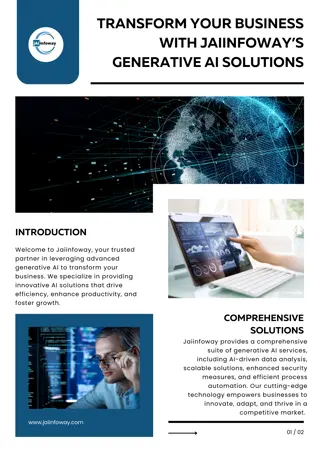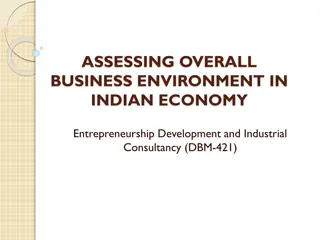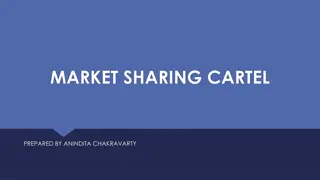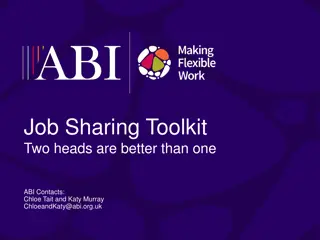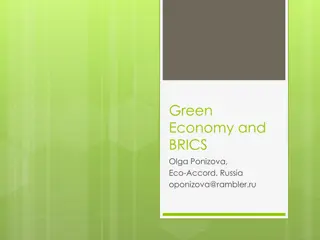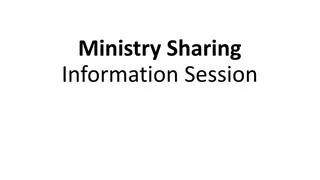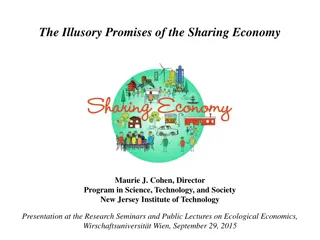Understanding Sharing Economy for Innovative Business Solutions
Sharing Economy, Business Innovation, Collaborative Economy, Digital Technologies, European Commission
Download Presentation

Please find below an Image/Link to download the presentation.
The content on the website is provided AS IS for your information and personal use only. It may not be sold, licensed, or shared on other websites without obtaining consent from the author.If you encounter any issues during the download, it is possible that the publisher has removed the file from their server.
You are allowed to download the files provided on this website for personal or commercial use, subject to the condition that they are used lawfully. All files are the property of their respective owners.
The content on the website is provided AS IS for your information and personal use only. It may not be sold, licensed, or shared on other websites without obtaining consent from the author.
E N D
Presentation Transcript
wideproject.eu SHARING ECONOMY Partner: IDP "The European Commission support for the production of this publication does not constitute endorsement of the contents which reflects the views only of the authors, and the Commission cannot be held responsible for any use which may be made of the information contained therein."
Objectives & Goals At the end of this module you will be able to: Understand the values and main features of sharing economy Know the differences between traditional and sharing economy Launch a business in sharing economy Ensure and match supply and demand on a sharing platform Be competitive and innovative in the sharing economy market "The European Commission support for the production of this publication does not constitute endorsement of the contents which reflects the views only of the authors, and the Commission cannot be held responsible for any use which may be made of the information contained therein."
Index Index Unit 1 Unit 1 - - Introduction to the Introduction to the s sharing economy haring economy Section 1: Section 2: Section 3: Section 4: Section 5: Section 6: A definition Main features History of sharing economy Advantages and disadvantages for services providers Types of platforms The Perren & Kozinest Matrix Unit 2 Unit 2 - - How to start a business in sharing economy How to start a business in sharing economy Section 1: Section 2: Section 3: Section 4: Section 5: Section 6: Business Idea How to start Supply and Demand Crowdsource supply Tips & Tricks How to be competitive "The European Commission support for the production of this publication does not constitute endorsement of the contents which reflects the views only of the authors, and the Commission cannot be held responsible for any use which may be made of the information contained therein."
1. Sharing economy A definition Sharing economy can be described as a new economic model in which goods and resources are exchanged or shared among individuals and groups in a collaborative way, such that physical assets become services. Sharing economy is strictly relayed to the development of new technologies of information and communication, which are combined with everlasting communal modes of operation. Here some of the most famous examples: "The European Commission support for the production of this publication does not constitute endorsement of the contents which reflects the views only of the authors, and the Commission cannot be held responsible for any use which may be made of the information contained therein."
1. Sharing economy Main features (Use of goods instead of property - temporary access to goods through borrowing or renting) Collaborative consumption Peer to peer exchange (service providers in direct contact with consumers Human relationships amongst equals) (two-sided platforms) Supply and demand matched on digital platforms Exploitation/better utilization of less used assets Exchange goods between consumers Buy less Reduced environmental impact, sustainability (against waste and excessive consumption) Less need to manufacture new products Less pressure on natural resources Cutting pollution and waste across the whole supply chain Protect the environment "The European Commission support for the production of this publication does not constitute endorsement of the contents which reflects the views only of the authors, and the Commission cannot be held responsible for any use which may be made of the information contained therein."
1. Sharing economy History of sharing economy Sharing Economy has developed in the United States, starting from 2008 as a reaction to the financial crisis. However, its basic idea is relatively old; the innovative feature is how network technology makes sharing possible on a global scale. Such model proves how digital technologies deeply affect the social structure and social interactions. Sharing Economy has been one of the most rapidly growing market in history. Since 2010, investors have contributed over $23 billion in venture capital funding to start-ups using a share-based business model. This phenomena gained great popularity through two start-up enterprises from San Francisco: Airbnb and Uber. The latter became the largest taxi company in the world in 10 years. It has revolutionised transport services by putting self-employed drivers directly in contact with other people through a digital platform. Did you know that The term Uberisation is used to indicate the economic phenomenon of: - Eliminating the intermediary - Digitalising services - Administrative ease "The European Commission support for the production of this publication does not constitute endorsement of the contents which reflects the views only of the authors, and the Commission cannot be held responsible for any use which may be made of the information contained therein."
1. Sharing Economy Advantages and disadvantages for services providers New areas of employment Flexible working hours Possibility of carrying out more jobs Free and attractive remuneration Reliance on technology Limited security Lack of legislative regulation and unfair competition "The European Commission support for the production of this publication does not constitute endorsement of the contents which reflects the views only of the authors, and the Commission cannot be held responsible for any use which may be made of the information contained therein."
1. Sharing economy Types of platforms Perren and Kozinest in their research paper Lateral Exchange markets (2018) provided a tool for better understand the different types of businesses operating in sharing economy. The tool takes the form of a matrix including two dimensions on which are based four types of sharing economy platforms 1. Consociality The degree members engage in a social interaction 1. Enablers in which the platforms 2. Forums 2. Platform intermediation The degree in which transactions flow to a platform provider 3. Matchmakers 4. Hubs "The European Commission support for the production of this publication does not constitute endorsement of the contents which reflects the views only of the authors, and the Commission cannot be held responsible for any use which may be made of the information contained therein."
1. Sharing economy The Perren & Kozinest Matrix Sharing Economy Typologies - Perren and Kozinest (2018) Forums Connect actors Matchmakers Pair actors High Consociality Hubs Enablers Equip actors Centralise exchange Low High Low Platform Intermediation "The European Commission support for the production of this publication does not constitute endorsement of the contents which reflects the views only of the authors, and the Commission cannot be held responsible for any use which may be made of the information contained therein."
2. How to start a business in sharing economy Business idea To launch a business in sharing economy, it is important to: Take the time to look for real problems that need real solutions, problems that can be best solved by communities themselves. Sharing is good (Buczynski, 2013) To get inspired these are some potential business ideas that might be adjusted to a particular target group or to a local context. Attire buy, sell and swap Peer-to-peer technology lending service Parking space rental platforms Jewellery rental Education sharing platforms Carpooling Social eating Hub of creative/business activities, co-working platforms Food delivery, food saving Freelancing platform "The European Commission support for the production of this publication does not constitute endorsement of the contents which reflects the views only of the authors, and the Commission cannot be held responsible for any use which may be made of the information contained therein."
2. How to start a business in sharing economy How to start 1. First of all, carry out desk research to find out real problems that need real solutions 2. After identifying the business idea, based on your experience and the results of the desk research, Test & Validate your idea Case in point: The founder of the Food Sharing App OLIO (see the Best Practice of this module), validated her idea on a WhatsApp Group, being a quick and low cost solution. She involved a small group of people living close to each other and asked them for 2 weeks to add any surplus food they had into the group. The result and feedback were very positive and the idea was launched. 3. Once validated, find out for investors willing to support your idea. If you do not possess the technical skills to design a platform, engage a development agency or professional developers (consider these costs when planning the initial budget) 4. Before the official launch of the product, a minimum viable product version of the platform should be launched so to collect feedbacks from the first users. 5. After the fine-tuning based on the inputs received, the business is ready to start. "The European Commission support for the production of this publication does not constitute endorsement of the contents which reflects the views only of the authors, and the Commission cannot be held responsible for any use which may be made of the information contained therein."
2. How to start a business in sharing economy Supply and Demand Sharing economy operates through two sided platforms, feeding both supply and demand. TRADITIONAL ECONOMY SHARING ECONOMY Firms recruit customers and create their own supply Firms recruit both customers and providers Services providers are employees of the company Providers are not employees How to balance supply and demand in sharing economy? While traditional firms can fire or hire employees, in sharing economy there are alternative strategies: Surging prices in a particular area when the demand is high through a specific algorithm; Reducing customers willing to pay for services and increasing providers willing to serve. "The European Commission support for the production of this publication does not constitute endorsement of the contents which reflects the views only of the authors, and the Commission cannot be held responsible for any use which may be made of the information contained therein."
2. How to start a business in sharing economy Crowdsource supply In sharing economy supply is crowdsourced and suppliers are not employees. Which are the risks? To leverage supply and demand different strategies should be adopted. 1. Less control on the suppliers 2. Risk of low quality services. Example A service that allows cars owners parking at the airport to rent out their cars to other travelers: How to mitigate those risks? 1. Careful selection of suppliers (background checks) - Secures renters through paid acquisition, such as display advertising or rental search aggregators; 2. Training and exams - Builds supply of car owners through public relations, press opportunities or word-of-mouth. 3. Rating system (eliminating suppliers with lower rates) "The European Commission support for the production of this publication does not constitute endorsement of the contents which reflects the views only of the authors, and the Commission cannot be held responsible for any use which may be made of the information contained therein."
2. How to start a business in sharing economy Tips & Tricks 1. Foster Trust Transparency is an essential part of the peer-to-peer world. Positive online reviews and ratings are indeed crucial for gaining consumer trust. Case in point: A Platform for pet sitting, connecting pet owners in need of boarding or sitting services, should foster trust through a 24/7 veterinarian consultations, premium pet insurance or the sharing of photos and videos of sitters interacting with the pets (see Rover). 2. Keep payments simple The entire process should be paperless and automated. Customers should be able to pay a flat fee through the online platform, while services providers should receive wages via PayPal, credit card or check. 3. Brand-building, networking and communication The sharing economy is about community and communication. Social media plays an integral role in the construction of the branding and the search for new clients or partners. Do not avoid negative feedbacks or criticism, always engage with them. "The European Commission support for the production of this publication does not constitute endorsement of the contents which reflects the views only of the authors, and the Commission cannot be held responsible for any use which may be made of the information contained therein."
2. How to start a business in sharing economy How to be competitive Today, there are plenty of sharing services and platforms available. People choose those services mainly because of lower prices; in order to keep the offer attractive, it is therefore necessary to be competitive in the price positioning. However, if the final goal is to create innovative solutions, there is much more to be done: Lack of regulation in sharing economy often results in the exploitation of the suppliers or negatively affects the traditional economy. There is an increasing awareness of the dark sides of sharing economy; for this reason, people are more and more in search for fairer and sustainable ways of consumption. New businesses should bring back sharing economy to its original meaning, to the creation and development of: Sustainable consumption practices Sense of belonging to a community "The European Commission support for the production of this publication does not constitute endorsement of the contents which reflects the views only of the authors, and the Commission cannot be held responsible for any use which may be made of the information contained therein."
Summing up Sharing economy is a new phenomenon that can bring to several opportunities. In costumers but also providers must be recruited. The supply crowdsourced, while demand match platforms. sharing economy not only must be and supply the on digital Sharing economy is based on peer-to-peer exchange, the use of digital platforms and sustainability. Crowdsourcing supply can be risky but there are different strategies to mitigate potential risks. Today there are plenty of sharing platforms. So how to be innovative? Sustainable consumption practices and the sense of belonging to a community are the key. "The European Commission support for the production of this publication does not constitute endorsement of the contents which reflects the views only of the authors, and the Commission cannot be held responsible for any use which may be made of the information contained therein."
wideproject.eu Thank you! Thank you! Partner: IDP "The European Commission support for the production of this publication does not constitute endorsement of the contents which reflects the views only of the authors, and the Commission cannot be held responsible for any use which may be made of the information contained therein."





